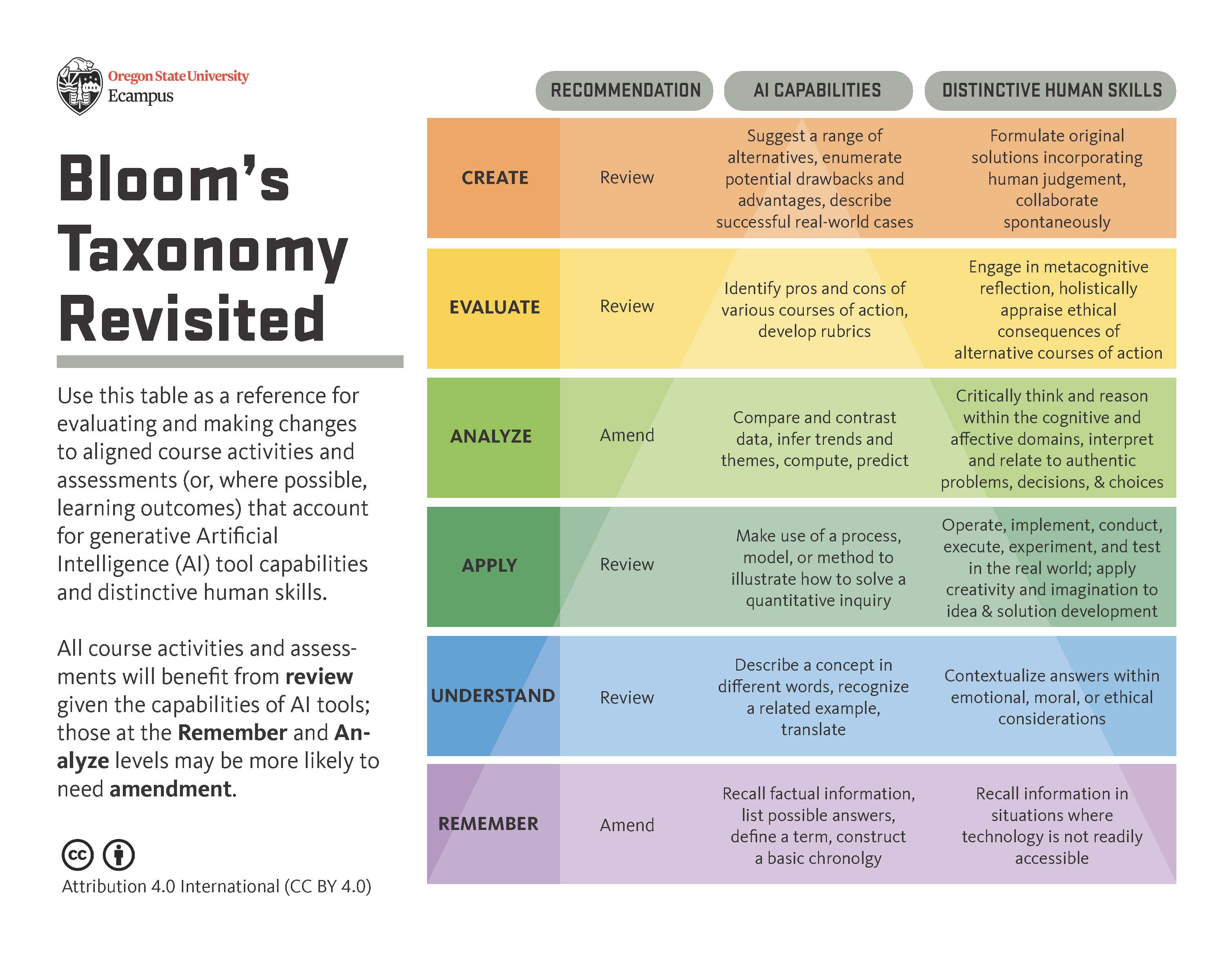Generative AI offers opportunities for learning, but instructors should guide students on using it safely, ethically, and within the parameters set by course policy. Continue to uphold assignment and assessment design that reinforces good teaching and learning practices. Use AI for teaching where appropriate and when it adds value.
Oregon State University’s “Bloom’s Taxonomy Revisited” provides a framework for assignment and assessment design in the age of AI.
Assignment Strategies with Generative AI in mind
- Use authentic assessment, formative assessment, assessment add-ons like problem-solving logs, exam wrappers, minute papers, “muddiest point” questions. Learn more: Assignments & Assessments
- Engage diverse media. Replace an essay or short-answer writing assignment with one that requires students to submit an audio file, podcast, video, speech, drawing, diagram, or multimedia project.
- Create connections to real-world experience that AI will not have. Connect assignments to very recent events or new conversations in the field; to issues specific to the local community; or to discussions that took place in your own classroom. Alternatively, ask your students to find a connection between course concepts/topics and their personal experience or knowledge.
- Ask your students to reflect and plan as part of learning. Reflecting and envisioning a future are two areas where generative AI’s performance remains quite weak. Create space for reflection and sharing after each learning unit. Make reflection and planning a routine part of written assignments that is gradable. Students will not be able to create strong submissions for such tasks using generative AI (also, feel free to tell them just that!)
- For example: instead of the traditional essay, which may now be easy to cheat through, assign a multimedia project accompanied by a brief self-reflective essay.
- Assign social annotation. For short reading responses, instead of using open-ended questions in Canvas, try social annotation tools that require students to engage with a text along with their classmates. Try Hypothes.is or Perusall, both of which are supported by the University.
- Incorporate ChatGPT in your classroom. The more familiar your students become with generative AI, including both its strengths and weaknesses, the less likely they will be to turn to it for generating submissions.
- Set clear course AI policies and expectations for assignments.
- Teach your students to cite generative AI correctly.
- Teach your students to use generative AI safely. ChatGPT acknowledges that they may share account holders’ personal information with third parties, including vendors and service providers — see their Privacy Policy. Teach your students to never share personal and sensitive information with generative AI chatbots.
- Model how to use generative AI as a personalized tutor.
- Assignment ideas with ChatGPT. Assignments that include generative AI can take on a variety of traditional formats: they can be designed as essay, a series of online discussion posts, or as in-class discussion, carried out in a large group or as think-pair-share activity. Whichever format you choose to go with, it is important to create space for a teacher-guided summarizing conversation in the end.
- Idea 1: Critical evaluation of AI outputs. Ask your students to 1. generate a ChatGPT response to a question of their own choosing, related to the field, 2. examine that response, and 3. write a short analytical essay about ChatGPT’s response’s strengths and weaknesses. *In this basic form, this exercise can be a great critical thinking exercise. It can also be tailored to other specific learning goals. For example, if you are looking to teach assessment and evaluative skills, you can ask your students to also come up with a set of assessment criteria, as opposed to the free-form discussion of the strengths and weaknesses.
- Idea 2: Applying concepts to analyze data. Ask your students to: 1. pick a concept related to the field. 2. ask ChatGPT to describe three applications of that concept. 3. rank those applications from most successful to least successful. 4. Explain your thought process behind the rankings. *This can be a written homework assignment or a classroom discussion activity.
- Idea 3: Identifying and understanding generative AI. Give your students two short human-written pieces or reading responses on a topic related to the field, and one AI-written piece on the same topic. The human-written pieces can be anything — student works, excerpts from publications, or any relevant online materials. Do not tell your students which one of the three pieces is AI-generated. Ask them to examine all three written pieces and 1. identify the AI-generated piece, 2. reflect on their thought-process: how difficult (or how easy) was it for them to identify the AI generated piece? what made them think it is AI-generated? in what ways does it stand out? *This exercise can also can be done as a discussion activity in the classroom or as a written assignment. Whichever format you choose, make sure that the essays are short enough and manageable to read in that specific format.
- Consult discipline-specific assignments that use AI for ideas:
- OFE collection of sample assignments using AI (Google Doc, requires a Montclair account). If you have an assignment that uses AI to help student learning, we invite you to share it with colleagues at Montclair. To have your assignment added to our collection, request editing access to this Google doc, or simply email a copy of that assignment to Vera at seninav@montclair.edu.
- University of North Dakota’s AI Assignment Library of peer-reviewed assignment ideas
- Chunk your written assignments with clear due dates for individual elements to precede the final submission.
- For example: Instead of one large submission due on May 5th, try assigning a project outline due April 1st, notes on research articles due Apr 15, first draft due Apr 25, and final draft due May 5th.
- Reward trying as well as producing. If a perfect product (test, paper) is the only way to receive an A, students are more likely to resort to cheating. Make sure you assess and reward the processes that are needed to be a strong learner in your course: reading, viewing, speaking, improving, reflecting on one’s learning, etc.
- Review your grading criteria and rubrics to make sure you’re setting your students up to adopt strong learning strategies. See Grading for Learning under Plan for Grading.
- Extend Flipped Learning: Ask students to read, view, and digest material at home, and then apply, demonstrate, and perform in class.
- For example: Have students write responses in class. If students have 20 minutes to write brief responses to the kinds of questions you might have provided as homework, they will learn a great deal, and as a bonus, your subsequent class discussion will benefit from that engaged individual work.
- Have students respond orally, requiring each student to respond to a different question.
- Have students work in small groups in class to present on topics in class.
- Incorporate brief in-class quizzes, tests and other assessments. The key is to make these short, frequent, and possibly even unannounced. They serve assessment purposes, reward attendance, and provide useful immediate feedback about learning. Small point values for individual assessments allow poor performance to be informative to students rather than disastrous.
- Engage visuals: ask students to respond to images or videos in their assignment. Be sure to include alt-text for accessibility.
- Reference materials that will not be in the AI’s data. For written assignments, ask your students to reference class materials, notes, discussions, or any sources that are not available on the free internet (books or articles that are recent, behind firewalls).
- For example: “Refer to two of the theorists discussed in class.”
- Try requiring handwritten responses where scope permits. Students will groan, and you may too as you attempt to read student handwriting again, but not only will this deter the use of ChatGPT, but some research shows that we actually remember better when we write by hand. Varying the way we engage with thinking has value as it plays to different students’ preferences, and stretches all of us to try new ways to help us focus on the task of thinking.
- Employ Simple Active Learning Strategies: In-class and in homework, active learning assignments inspire learning.
- Collaborative Learning: Sometimes called team or group learning, collaborative learning can be designed to accelerate learning.
Montclair’s Digital Accessibility Initiative, ITDS, and DRC offer a variety of resources for faculty to create accessible materials for students. Following Universal Design for Learning principles benefits all students.
Generative AI tools that enhance functions such as text to speech, speech to text, text to image, voiceovers, image descriptions, and PDF paraphrasing can potentially increase the accessibility of assignments and classroom materials for students with disabilities.
Resources:
- McDermott, B. (2024). AI as an Accessibility Tool: Using Generative AI to Support Universal Design for Learning Approach. In S. Mahmud (Ed.), Academic Integrity in the Age of Artificial Intelligence (pp. 162-174). IGI Global. https://doi.org/10.4018/979-8-3693-0240-8.ch009
- TriCollege Libraries (Bryn Mawr, Haverford, Swarthmore)’s “Generative AI in Higher Education”. Page has sub-sections on AI assistive technologies and accessibility.
- University of Cincinnati Libraries’ “AI Tools for Accessibility“
Last Modified: Monday, July 8, 2024 4:46 pm
CC
![]()
Teaching Resources by Montclair State University Office for Faculty Excellence is licensed under a Creative Commons Attribution-NonCommercial 4.0 International License
Third-party content is not covered under the Creative Commons license and may be subject to additional intellectual property notices, information, or restrictions. You are solely responsible for obtaining permission to use third-party content or determining whether your use is fair use and for responding to any claims that may arise.

